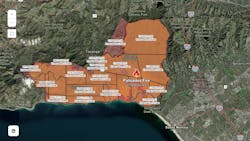The images on our screens have been astonishing. The orange glow across Los Angeles as seen from the Griffith Observatory; arial shots of acres of smoldering ruins; lines of parked luxury cars, covered in ash, haloed in sparks; and soot-stained firefighters, their faces masks of exhaustion.
As of this writing, the 2025 California Wildfires which began on January 7th are still burning. According to the Cal Fire website (www.fire.ca.gov) the disaster currently involves 255 different fires that have so far burned 50,683 acres, destroying more than 16,000 structures. Confirmed fatalities number at 28, which is a horrifying number, but still seems mercifully low given the scope of the crisis.
The largest and most devastating of these fires, the Pacific Palisades Fire in Los Angeles County—which has burned 23,448 acres—currently stands at 72% containment. Containment, it should be noted, means only that the fire is no longer spreading; within that area of containment a fire can still be burning.
This is a plumbing magazine, and plumbing intersects with so many facets of our day-to-day lives—cooking, cleaning, bathing, drinking—but almost nothing brings the absolute necessity of well-designed water systems so clearly into focus as buildings on fire.
And one of the many big stories coming out of the California wildfires has been inadequate water supply to combat the blaze, with firefighters reporting they had low pressure or even no pressure in certain areas (www.nytimes.com).
We live in a politicized and polarized age, so it was little surprise that President Elect Donald Trump was quick to point the finger at California Governor Gavin Newsom on January 8th in a Truth Social post accusing him of putting environmental concerns over the well-being of Californians in his water management policy (https://truthsocial.com/@realDonaldTrump/posts/113793724958051185).
But the truth, as reported in our sister publications Water World (which serves the municipal water community) and Stormwater Solutions (which serves the stormwater and erosion control industry) is more complicated.
(And I would like to take a moment here to thank them—and Endeavor Business Media’s entire Water Group—for the fine work they have been doing covering what has been a complicated and fast-moving subject.)
In an interview with Dr. Mark Gold, Director, Water Scarcity Solutions, Environmental Health for the Natural Resources Defense Council (and himself a southern California resident), the Metropolitan Water District of Southern California, at the time of the crisis, had the most water stored in the reservoir system in the history of the agency. Why? Because the previous two-and-a-half years were some of the wettest on record.
But conversely, the last eight months have been some of the driest on record. “We’ve had 0.16 inches of rain since May 5 of last year,” Dr. Gold said. “It’s the second driest period from May to January in 150 years in California.”
Then, just as the fires broke out, came the Santa Ana winds, extremely dry katabatic winds that originate inland and affect coastal Southern California and northern Baja California, that created gusts from 60 to 100 mph, with sustained winds in the 30 to 40 mph range.
Those winds not only fanned the flames but made it impossible for air support to get off the ground in the early stages of the disaster. Given how fast the fires spread, and without help from the airtankers, water distribution systems were simply overwhelmed.
In the past few years, I’ve seen the conversation shift from sustainability—designing systems that will limit climate change—to resiliency—designing systems that will instead cope with the effects of climate change. I think, when the time comes to rebuild in California, we will see the results of that conversation manifest in a great deal of the system design and building practices involved.
About the Author
Steve Spaulding
Editor-in-Chief - CONTRACTOR
Steve Spaulding is Editor-in-Chief for CONTRACTOR Magazine. He has been with the magazine since 1996, and has contributed to Radiant Living, NATE Magazine, and other Endeavor Media properties.
